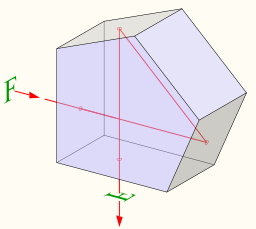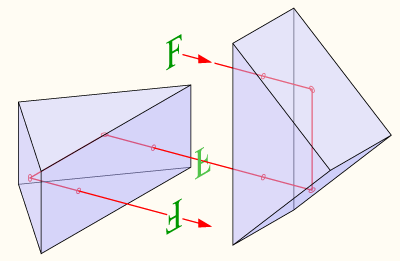.
Porro prism

In optics, a Porro prism, named for its inventor Ignazio Porro, is a type of reflection prism used in optical instruments to alter the orientation of an image.
It consists of a block of glass shaped as a right geometric prism with right-angled triangular end faces. In operation, light enters the large rectangular face of the prism, undergoes total internal reflection twice from the sloped faces, and exits again through the large rectangular face. Because the light exits and enters the glass only at normal incidence, the prism is not dispersive.
An image travelling through a Porro prism is rotated by 180° and exits in the opposite direction offset from its entrance point. Since the image is reflected twice, the handedness of the image is unchanged.
Porro prisms are most often used in pairs, forming a double Porro prism. A second prism, rotated 90° with respect to the first, is placed such that the beam will traverse both prisms. The net effect of the prism system is a beam parallel to but displaced from its original direction, with the image rotated 180°. As before, the handedness of the image is unchanged.

Double Porro prism systems are used in small optical telescopes to re-orient an inverted image (an arrangement is known as a image erection system), and especially in many binoculars where they both erect the image and provide a longer, folded distance between the objective lenses and the eyepieces.
Commonly, the two components of the double Porro system are cemented together, and the prisms may be truncated to save weight and size.
A single Porro prism is a type of roof prism, though it is not used in this way in binoculars.
A variation on the double Porro prism is the Porro-Abbe prism.
Retrieved from "http://en.wikipedia.org/"
All text is available under the terms of the GNU Free Documentation License

